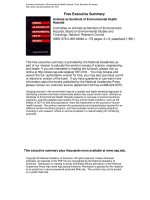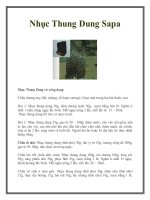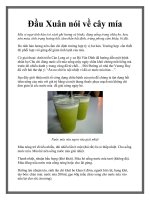Science,Medicine,and Animals potx
Bạn đang xem bản rút gọn của tài liệu. Xem và tải ngay bản đầy đủ của tài liệu tại đây (3.4 MB, 56 trang )
Science, Medicine, and Animals
CONTENTS
) ) ) ) )
Preface 1
Introduction 3
SIDEBAR:
Why Use Animals? 5
A Theory of Germs 7
SIDEBAR:
Overcoming Disease 8
Vaccines 9
SIDEBAR:
Penguins! 12
Understanding Epilepsy 13
Surgical Advancements 17
Cancer Therapies 18
The Concept of Basic Research 20
Safety Testing 21
SIDEBAR:
Cruelty Free 28
Regulation of Animal Research 29
Continuing Efforts to More Efficiently
Use Laboratory Animals 37
SIDEBAR:
The 3 Rs in Action 39
Conclusion 40
Resources and Web Links 41
PREFACE
) ) ) ) )
science,
and
medicine,
animals
T
he lives of humans and animals have been intertwined since the beginning of civilization.
Early humans learned to raise animals for food as well as to live alongside them as com-
panions. Humans and animals develop strong interactions and lasting bonds to their
mutual benefit. It is because of our close ties with animals that many people have mixed feelings
about the use of animals in biomedical research—even scientists. In an ideal world, scientists would
never need to use animals as research subjects. Because we do not live in an ideal world, some diffi-
cult ethical and moral questions arise.
First and foremost, is it ethical to allow humans and animals to suffer from injury and disease when
treatments and cures can be discovered through animal research? Public opinion polls have consis-
tently shown that a majority of people approve of the use of animals in biomedical research that
does not cause pain to the animal and leads to new treatments and cures. However, another difficult
question is whether it is morally acceptable to perform research on animals that is painful, if it leads
to new and better treatments such as new anesthetics and painkillers. Or, is it acceptable to perform
any research on animals if new treatments or cures resulting from the research might not be apparent
for decades, if ever?
A minority ot people polled thought that experiments should be done on humans rather than animals.
To some extent this does occur during clinical trials, but only after extensive animal testing to ensure
that harmful drugs are not given to humans. In our society, most people consider it morally wrong to
use humans as subjects for basic research, under the premise that humans deserve higher moral con-
sideration than animals.
Some people also claim that it is unnecessary for animals to be used as research subjects and that
computer or other nonanimal models could be used instead. In some cases this is true, and scientists
strive to use computer models and other nonanimal methods whenever possible; however, many of
1
2
the interactions that occur between molecules, cells, tissues, organs, organisms, and the environment
are too complex for even the most sophisticated of computers to model. At present, it is impossible to
advance biomedical science without the use of animal subjects for some aspects of research.
Questions about animal research can be difficult to answer. This report is meant to help you decide
how YOU will answer these questions. It details how animal models fit into the larger scheme of bio-
medical research, some of the advances in biomedical research that have been gained because of
animals, and the regulations that protect animals and manage their use. This report will help you to
understand the important role animals play in biomedical research and to decide whether the bene-
fits of animal research justify the use of animals as research subjects.
3
D
iseases cause a staggering amount of suffering and death in both people and animals.
As a result, human society has committed itself to alleviating the suffering caused by
disease. Toward this goal, biomedical research has included the use of animals as one
component of research to understand, treat, and cure many human and animal diseases. This publi-
cation (1) discusses how animals were and continue to be an important component of biomedical
research, (2) presents the role animals play within the whole picture of biomedical research, (3) dis-
cusses the regulations and oversight that govern animal research, and (4) discusses continuing efforts
to use animals more efficiently and humanely in biomedical research.
Throughout history, people have sought to reduce our vul-
nerability to the hardships and dangers of life. We have
given up the wandering habits of our ancestors to settle in
groups and cultivate the land to ensure a regular supply of
food. We have built shelters to guard us from the weather
and have crafted weapons to defend ourselves against
predators. We have also tried to protect ourselves from a
threat that is not always visible, but is often deadly—disease.
History is littered with examples of lethal diseases that strike and spread rapidly. Cholera, smallpox,
polio, and influenza outbreaks have sickened, disabled, or killed hundreds of millions of people. The
outbreak of the bubonic plague (caused by the bacteria Yersinia pestis) during the 14th century
killed 25% to 50% of all people in Europe, the Middle East, China, and North Africa.
BUBONIC PLAGUE— A disease caused by the
Yersinia pestis bacterium. Characterized by
swollen lymph nodes and bleeding beneath
the skin, often leading to death. Also called
the “Black Death” during the 14th-century
outbreak.
INTRODUCTION
) ) ) ) )
Infectious diseases and those caused by parasites or malnutrition are not the only challenges to
health we have faced. The ancients recognized epilepsy and called it “the sacred disease,” believing
that the seizures of epileptics were caused by gods or demons. Babylonian documents describe the
symptoms of epilepsy, as do Greek and Roman medical texts. Cancer too was known and feared by
our ancestors, who attempted to heal these diseases with remedies both natural and magical.
Eventually doctors and scientists turned to the study of animals to help them understand the mysteries
of anatomy and the riddles of disease.
So why do scientists study animals to understand human disease? They do so because people are
vulnerable to many of the same or similar diseases as animals. Humans have 65 infectious diseases
in common with dogs, 50 with cattle, 46 with sheep and goats, 42 with pigs, 35 with horses, and
26 with fowl. We have lived with and among these animals for thousands of years, so it is not sur-
prising that we are susceptible to some of the
same parasites, viruses, and bacteria as animals,
including some that can be transmitted between
animals and people such as rabies and malaria.
Nor is it surprising that many chronic, noninfec-
tious diseases such as epilepsy also afflict other
species. The parallels between human and ani-
mal physiology and pathology were noted long
ago, and the practice that we today call “animal
research” has roots stretching back to ancient Egypt and Greece.
4
cancer
epilepsy
PHYSIOLOGY— All the functions of a living
organism or any of its parts.
PATHOLOGY— The structural or functional
manifestations of a disease.
why study animals?
PARASITE— An organism that depends
upon another organism (host) for its
nutrients and protection, usually
harming the host in the process.
Animals are just one type of model that scientists use in biomedical
research to simulate biological functions and organizations:
Molecular models simulate the interactions and functions of molecules and how these
molecules form larger structures like proteins and DNA. For example, molecular models help scien-
tists understand how protein structures inside heart cells cause the heart to contract and pump blood.
Cellular models simulate how structures interact inside a cell and how a cell functions. For
example, cellular models help scientists understand how cells produce an electrical charge that caus-
es the heart to beat.
Tissue models simulate how cells interact to form tissues and how the tissues function. For
example, tissue models help scientists determine how the many electrical cells in the heart synchro-
nize to produce electrical charges at the same time.
Organ models simulate how multiple tissues organize and function as organs. For exam-
ple, organ models help scientists understand how the four different chambers of the heart work
together to pump blood throughout the body.
System models simulate how multiple organs interact and form a system. For example,
system models help scientists understand how the heart, arteries, veins, and capillaries (called the
cardiovascular system) all work together to move blood from the heart to the body.
Organism models simulate how different systems work together to allow an animal to
respond to its environment. For example, organism models help scientists understand how stress
causes high blood pressure.
5
Many questions about molecular, cellular, tissue, and even organ functions can be investi-
gated using test tube, cell culture, and tissue culture models. But some questions, such as
how the digestive system interacts with the cardiovascular system or how the environ-
ment affects an organism, can only be answered using animal models.
why
use
animals
?
6
Even though animals differ from people in many ways, they also are very similar to people in many
ways. Animals develop many of the same diseases as people, including hemophilia, diabetes, and
epilepsy. Animals are also susceptible to many of the same bacteria and viruses as people, such as
anthrax, smallpox, and malaria. An animal is chosen as an “animal model” for research only if it
shares characteristics with people that are relevant to the research. For example, Louis Pasteur was
able to use dogs as an animal model for studying rabies. He was able to develop a rabies vaccine
because (1) dogs and people can both develop rabies, and (2) the immune systems of dogs and
people react to the rabies virus in the same way. For this research, it did not matter that humans
and dogs differ in other ways; for example, dogs cannot develop AIDS or measles, diseases that do
affect humans.
People Often Ask the Questions
“How can the research be useful when animals are different
from people?”
“People and animals suffer from different diseases, so how can
scientists justify performing experiments on animals?”
ANIMAL MODEL— An animal in which normal
biology and behavior or a disease or disability
can be studied, and in which the normal or
abnormal biology is similar to that in humans
AIDS (acquired immunodeficiency syndrome)—
A fatal disease caused by the HIV virus. The HIV
virus destroys T cells, which are the cells that
fight infection. Eventually, the immune system is
weakened enough that common illnesses
become life threatening.
. . . why use animals? (cont.)
7
T
oday, it is hard for us to fully appreciate the great revolution in medicine known as “germ
theory” and the role that animal research played in its development. It seems impossible
that people once believed that foul odors could create disease or that “evil spirits” could
cause a person to become ill. We have also forgotten how rare it was for parents to see all of their
children survive to adulthood. Still, it has been little more than a century and a half since Robert
Koch made the discoveries that led Louis Pasteur to describe how small organisms called germs could
invade the body and cause disease.
In the final decades of the 19th century, Koch conclusively established that a particular germ could
cause a specific disease. He did this by experimentation with anthrax. Using a microscope, Koch
examined the blood of cows that had died of anthrax. He observed rod-shaped bacteria and sus-
pected they caused anthrax. When Koch infected mice with blood from anthrax-stricken cows, the
mice also developed anthrax. This led Koch to list four criteria to determine that a certain germ
causes a particular disease. These criteria are known as Koch’s Postulates and are still used today.
Integral to these criteria is Postulate #3, “The disease must be reproduced when a pure culture is
inoculated into a healthy, susceptible host.” Even today, with all of the advances in
modern science, it would be impossible to prove that a specific germ is
responsible for a disease without the use of laboratory animals.
Anthrax
ANTHRAX— A disease caused by Bacillus
anthracis
bacteria. Can cause skin lesions
(cutaneous anthrax), breathing difficulties and
shock (inhalation anthrax), or severe vomiting
and diarrhea (gastrointestinal anthrax).
CULTURE —Micro-organisms, tissue cells,
tissue, or other living matter grown in a spe-
cially prepared nutrient medium. Also refers
to the cells grown, i.e., a culture of bacteria.
discovering
anthrax
A THEORY OF GERMS
) ) ) ) )
GERM— A disease-causing organism, such
as a bacteria, parasite, or virus, usually
single celled.
8
Until the 20th century, it was common to lose a child to disease. Smallpox, polio, diphtheria, whoop-
ing cough, tetanus, measles, and mumps maimed and killed thousands of children every year. But due
to the development of vaccines, there has not been a single natural case of smallpox in the world since
1977, polio has been eradicated in the Western Hemisphere, and whooping cough, tetanus, and
mumps are rarely seen in developed countries.
Smallpox causes blisters similar to chickenpox. Smallpox is easily
spread through coughing or sneezing, or through contact with con-
taminated clothes or bed linen. Twelve and 14 days after exposure,
the patient develops a fever with severe aches and pains. A rash
then appears over the entire body including the palms of the hands
and soles of the feet. Death occurs in 30% of patients due to a mas-
sive immune response that causes clotting of the blood and organ failure. Vaccination before exposure
to smallpox prevents the illness. There is no known treatment; however, vaccination up to 5 days after
the exposure may help to prevent death.
Polio is caused by a virus that enters through the mouth and is easily
transmitted from person to person, particularly between children during
the summer months. It causes headache, fever, and aches before entering
the bloodstream and infecting the nerves controlling movement. The dis-
ease causes paralysis in the arms and/or legs (spinal polio), throat, eyes,
face, heart, or lungs (bulbar polio), or both (bulbospinal polio). It can
lead to suffocation and death caused by paralysis of the lung muscles.
Before the invention of the “iron lung,” about half of children with bulbar or bulbospinal polio died.
disease
“In 1736 I lost one of my sons, a fine boy of four years old, by the small-pox, taken in the common way. I
long regretted bitterly, and still regret that I had not given it to him by inoculation [had his son vaccinated].
This I mention for the sake of parents who omit that operation, on the supposition that they should never
forgive themselves if a child died under it; my example showing that the regret may be the same either way,
and that, therefore, the safer should be chosen.”
Benjamin Franklin, His Autobiography: 1706-1757
overcoming
malaria
death
multiplying
VACCINE —Weakened or killed germs or
part of a germ that when injected into a
body stimulates antibody production and
immunity against the germ but is incapable
of causing a disease.
Koch’s Postulates —1. The agent must be present in every case of
disease 2. The agent must be isolated from the host and grown in
a laboratory dish. 3. The disease must be reproduced when a
pure culture is inoculated into a heathy, susceptible host. 4. The
same agent must be recovered again from the experimentally
infected host.
9
VA CCINES
) ) ) ) )
B
y infecting animals with certain microbes, Koch, Pasteur, and other researchers were able
to identify the germs causing anthrax, rabies, diphtheria, and plague. These discoveries
have allowed scientists to develop vaccines for animals and people made from weakened
germs. The safety and effectiveness of these vaccines are also tested in laboratory animals. One of
the first vaccines developed was against anthrax. Louis Pasteur weakened anthrax bacteria by heat-
ing it so that it could no longer cause illness. He then vaccinated one group of sheep with the
weakened anthrax bacteria. This vaccination caused the sheep’s immune system to recognize
the anthrax bacteria and produce antibodies against it. He later infected the vaccinated group
and a nonvaccinated group with live anthrax. The vaccinated group all survived, proving that
the vaccinated animals’ immune systems would recognize and fight the live anthrax and thus
prevent the disease. Pasteur used animals to prove that vaccination was generally safe and
would prevent disease, which in turn has saved many farm animals and people from death
by anthrax.
Unfortunately, developing a vaccine is not always simple or easy. Take for instance
malaria, another disease that Koch studied during the late 19th century. Malaria is one of the
most ancient parasitic diseases affecting humankind, and its very name summons up a
time when the origins of disease were shrouded in mystery. The Italian phrase mala aria
(bad air) was first used to describe the supposed cause. Malaria is character-
ized by high fever, shivering, joint pain, headache, vomiting, and possibly
convulsions and coma ending in death. Malaria remains a public health
problem of staggering magnitude. There are 300 to 500 million new infec-
tions and 1.5 to 2.7 million deaths throughout the world each year, most of
them among children.
Malaria is caused by a parasite called Plasmodium. This small single-cell organism invades the liver
and metamorphoses so that it can burrow into red blood cells. The parasite then multiplies until the
red blood cells burst, causing the host body (human or animal) to be assaulted by waves of fever as
the body attempts to destroy the parasite. In some cases, the infected red blood cells become stuck in
the arteries and veins of the head, leading to death. In the early 20th century, Robert Ross used
Koch’s Postulates to prove that bird malaria was transmitted from bird to bird by mosquitoes. The
next year, a team of Italian scientists showed that human malaria
was also spread by mosquitoes, paving the way for a series of sim-
ple measures to interrupt the transmission of the disease, such as
the use of bed nets and insecticides. But because the malaria para-
site metamorphoses as it moves from the liver to the red blood
cells, it has been difficult to develop a vaccine that will stimulate the
host’s immune system into recognizing the two different forms of
the parasite.
Even though scientists have not yet been able to develop a malaria vaccine, animal research has
played an important part in developing drugs to treat malaria and helps scientists understand how
to develop a vaccine for a parasite with two different forms. Dr. Nirbhay Kumar, professor in the
Department of Molecular Microbiology and Immunology at the Johns Hopkins Bloomberg School of
Public Health, has been studying malaria using several animal model systems including chicken and
rodent models of malaria, even though these animal malaria parasites cannot infect humans. Results
from the research on these animal models allow him to understand how the parasite infects liver
10
and blood cells and completes its transmission through an extensive develop-
ment inside the mosquito vector. The major life-cycle events of this deadly
human parasite are very similar if not identical among all the different animal
models. Dr. Kumar points out, “The knowledge that we gain from animal
malaria studies can often extrapolate to human malarias.”
Dr. Kumar is using the knowledge that he has gained by studying chicken and
murine malaria to develop new vaccines. He tests these new vaccines in mice
and nonhuman primates to help assess whether the vaccines will stimulate the
correct type of immune responses to cure people of malaria, another example of how studying ani-
mals with similar but not identical diseases is helpful.
Dr. Kumar points out that scientists must think carefully about using animals in their research. “We
must be careful and judicious in our use of animals,” he says. “We should use them only because
there is no other way. There must be real justification for animal use.” With a child dying of malaria
every 20 seconds somewhere in the world, he notes, “in this case, there is a justification.”
11
The Baltimore Zoo is located in Druid Hill Park, a green oasis in the midst of a concrete desert. But
the large colony of penguins living at the zoo must cope with a bloodthirsty adversary capable of
transforming this oasis into an intensive care unit: the plasmodium-laden mosquitoes that infest the
park and transmit a deadly strain of malaria. “This is a problem in zoos throughout North
America,” says Dr. Thaddeus Graczyk, Associate Research Professor in the Department of Molecular
Microbiology and Immunology at the Johns Hopkins Bloomberg School of Public Health. “This is a
huge problem for the zoo because there is very high mortality among the newly hatched and juvenile
penguins.” The penguins hatch in winter and are still young and vulnerable in May or June, when
the mosquitoes in Baltimore begin to bite. “We’ve captured a few of the mosquitoes and have seen
that they all carry the parasite,” says Graczyk. But malaria is not just a problem for penguins
in zoos. Malaria is also becoming a problem for wild populations, such as African penguins. African
penguins are particularly vulnerable to the malaria parasite because they are a “naive” population;
they have never encountered malaria before. African penguins are found on islands off the coast of
South Africa, in a harsh climate where at one time there were no mosquitoes or malaria. But human
development brought mosquitoes, and African penguins are now catching malaria, just like the
Baltimore Zoo penguins. The penguins of the Baltimore Zoo have become an important ally in the
quest to develop a malaria vaccine for African penguins and even people. If a penguin sur-
vives the first time it becomes infected with malaria, it is much more likely to survive a second bout.
By studying the Baltimore penguins, Graczyk and his colleagues have identified antibodies created
by the penguins’ immune systems that attack the malaria parasite and help them survive the disease.
By identifying antibodies against malaria, this may help develop a malaria vaccine for penguins.
Because of the similarities between malaria in penguins and humans, this development may also lead
to a malaria vaccine for people.
12
penguins!
I
n imperial Rome, epileptics were encouraged to enter the Coliseum and drink the blood of
wounded gladiators. This magical “cure” was thought to be effective in banishing the seizures
that caused epileptics to be feared and shunned by other citizens. Throughout the Middle Ages,
epilepsy was believed to be an infectious disease, and epileptics were routinely confined to insane
asylums during the 18th and 19th centuries. Even as late as 1933, epileptic inmates of U.S. mental
health institutions were forcibly sterilized in an erroneous attempt to prevent them from passing their
genes on to their children.
Today, there is still no cure for epilepsy. Medications can effectively control seizures in 70% of
patients. Others, whose seizures are caused by abnormal electrical activity in parts of the brain that
can safely be removed, undergo surgery. However, medications can have serious side effects, and
brain surgery is an option in only a very small percentage of cases. This still leaves about 30% of
patients whose seizures cannot be controlled by medication or surgery, highlighting the need for
continuing research into the brain and epilepsy.
In the laboratory of Dr. Michael Rogawski at the National
Institutes of Health (NIH), scientists are seeking to understand the
mechanisms of abnormal electrical activity in the brain at the
cellular and molecular level and to develop drugs that will con-
trol seizures without side effects. “Epilepsy is a chronic disease
that can be a severe impediment to living a normal life,”
Rogawski explains, due to the difficulties caused by frequent or
uncontrolled seizures and the disabilities that can be associated
13
drink
the
blood
NIH (National Institutes of Health)— A federal
agency whose mission is to acquire new
knowledge to help prevent, detect, diagnose,
and treat disease and disability. NIH is the
federal focal point for medical research in the
United States.
EPILEPSY— Neurological disorder characterized
by sudden attacks of motor or sensory malfunc-
tion with or without loss of consciousness or
involuntary muscle contraction.
UNDERSTANDING EPILEPSY
) ) ) ) )
with the disease or the drugs used to treat it. Because brain activity in epileptics is normal between
seizures, “it’s a challenge to develop a drug that will target only the abnormal activity without inter-
fering with normal brain functions.”
The study of epilepsy in the laboratory begins in vitro. Researchers have learned to simulate a
seizure in a culture of neurons, creating a “seizure in a dish.” Unlike bacteria or plant cells, animal
neurons when grown in a petri dish (cell model) are capable of forming simple connections that are
similar to the connections made between neurons in the brain. This process makes it possible to
assess the potential anticonvulsant properties of new drugs. “When trying to characterize the molecu-
lar actions of the drugs, we study them in cultured neurons,” Rogawski says. Cultured rat neurons
lack the complex connections between brain regions that are present in whole brains or brain slices
but are still useful in the early stages of research. After a chemical compound’s activity has been thor-
oughly studied in a cell model, the researchers use 1⁄ 2-mm-thick brain slices from young adult rats.
The use of a brain slice (tissue model) allows researchers to understand how electrical activity in one
region of the brain affects and interacts with another part of the brain. Researchers are able to
obtain dozens of brain slices from a single animal, allowing them to perform several studies using
only a single rat brain and reducing the number of animals needed for this type of research. “We
can then wash potential drugs over the surface of the slice instead of injecting the whole animal,”
Rogawski says. If a new drug looks promising, the researchers then test the drug in animals (organ-
ism model). Without administering the drug directly to an animal model, scientists could not be cer-
tain that a drug would have therapeutic value or be safe in people. He explains that “the brain is an
incredibly complex, interconnected organ. Cells or slices in a dish, while useful in the earlier stages
of research, cannot completely predict the effect of a drug on an intact brain.”
14
IN VITRO— An artificial environment
outside a living organism such as a
petri dish.
NEURON— A type of cell that conducts
electrical impulses; also called a nerve
cell; found in the brain, spinal column,
and nerves.
&
brain epilepsy
ANTICONVULSANT— A drug or
procedure able to stop a seizure.
15
“Once a drug has been shown to be effective in pre-
venting seizures in an animal model, we look for side effects in
that model,” Rogawski says. Does the drug interfere with motor coordination or
memory, for example? Researchers also need to determine the dose that will prevent seizures with
the lowest incidence of side effects, work that also can only be performed in whole animals.
Drugs developed in Rogawski’s laboratory at NIH are now being tested in people, a potential boon
to the 2.5 million Americans who have epilepsy. Although advances in cell culture and computer
modeling have reduced the need for animals in research, Rogawski notes, “We still have an absolute
requirement for animal models,” in studying diseases like epilepsy. “The brain has billions of neurons
. . . and the complexity of that system is far greater than a computer can simulate. It is absolutely
essential to study the action of potential new drugs in a complete nervous system.”
Rogawski’s research takes advantage of the fact that epilepsy is not only a human disease. Seizures
occur frequently in many purebred dogs and in baboons, as well as other species. But Rogawski and
his colleagues use primarily rats and mice in their research. “They breed easily and we can control
their genetics much more easily,” he says.
Genetically modified rats and mice, like those used in Rogawski’s research, are an important new
tool for researchers. By altering a specific gene, scientists are able to breed rodents with diseases
similar or identical to those in humans.
Genetically modified rats and mice are often
16
excellent models of human disease, which is one of the reasons that 90% of all animals used in U.S.
research today are rats and mice.
GENETICALLY MODIFIED ANIMALS
Genetically modified animals (sometimes called trans-
genics) are developed by altering an embryo’s genes,
either by treatment with chemicals or by adding or
removing a gene. Most genetically modified animals
are mice that are developed to mimic a human dis-
ease. For example, one type of genetically modified
animal has the gene for a protein called pro-opiome-
lanocortin (POMC) “knocked out” or made nonfunctional. POMC is converted by the body into hor-
mones that influence pigmentation, food intake, and fat storage. People with alterations in the POMC
gene become severely obese as infants and have red hair. POMC knock-out mice are severely obese
and have yellow rather than brown fur, mimicking the human disease. POMC knock-out mice are
being studied to understand how the body controls hunger and metabolism. They are also used to
test new drugs to treat obesity.
Genetically modified animals can be useful even if they are not created to mimic a disease. Take for
instance the “green mouse.” Green mice have a jellyfish gene called “green fluorescent protein”
inserted into their genomes. This jellyfish gene encodes a protein that glows green under ultraviolet
(UV) light. Therefore, when green mice are exposed to UV light, every single cell in their body glows
green. Scientists use these mice to study a wide variety of immune diseases, even though these mice
are perfectly normal. By studying green mice, scientists have studied how immune cells from the
mother are passed to infants through breastfeeding, how different immune cells interact, and how
fetal immune cells migrate out of the womb and into the mother’s organs, which may cause some
autoimmune diseases.
GENOME— All of the genetic material or
DNA of an organism.
Newborn
“green mouse”
T
hough animal research has helped to devel-
op drugs and vaccines to control and cure
many infectious diseases, many surgical pro-
cedures were and continue to be developed through the
use of animal models. Organ transplantation, open heart
surgery, and many other common procedures were developed
using animal models.
Animal research was essential in developing many life-saving surgical
procedures once thought impossible. Heart valve replacement is now a common
procedure, and development of these artificial heart valves as well as the artificial hearts now being
tested in people would not have been possible without animal research. Organ transplants and coro-
nary artery bypasses require that blood vessels be sewn together. The technique of sewing blood ves-
sels together was developed through surgeries on dogs and cats by Alexis Carrel, for which he was
awarded a Nobel Prize in 1912. Research on laboratory animals also led to the understanding of
organ rejection and how to overcome it.
17
SURGICAL ADVANCEMENTS
) ) ) ) )
A
nimal studies have already contributed to the development of a drug that has been
described by some as “the vanguard in a new generation of cancer drugs.”
Gleevec, a chemotherapy that works by inhibiting a protein that contributes to can-
cer cell growth, is the first effective treatment for people with chronic myeloid leukemia. Gleevec
was developed using cell cultures and mouse studies. Like the research programs devoted to
developing a malaria vaccine and treatments for epilepsy and heart disease, cancer research
requires the use of many different models. Cell and tissue culture, whole animal models, and
clinical (human) studies help scientists better understand both the cause of various diseases and
better ways to prevent, treat, and possibly cure them. All of these methods were used in the
development of Gleevec. In order to develop a new drug to treat a disease, it is necessary to
make use of all of these models. Culture, animal, and human studies each play an important
role in the struggle to understand disease and develop cures.
growth
cancer cell
18
GLEEVEC— A drug that is highly effective in treating chronic myeloid leukemia. Although it took more than
a decade of laboratory work to develop Gleevec, the drug gained FDA approval in less than 3 years.
Typically, it takes 14 years to win FDA approval by proving that a new drug is safe and effect through
clinical trials. Novartis, the pharmaceutical company that developed Gleevec, reports that it spent between
$350 million and $500 million from 1985 to the time the drug was approved by the FDA in May 2001. On
the basis of promising animal and human studies, the FDA accelerated the review process and approved
Gleevec after only 32 months. There is no other safer effective treatment for people with chronic myeloid
leukemia, one of the reasons why the FDA’s review of Gleevec was the fastest ever recorded for an anti-
cancer drug in the United States.
CANCER— an abnormal and uncontrolled
growth of cells in any part of the body.
CHEMOTHERAPY— Treatment of a dis-
ease with a chemical that has a toxic
effect on cancerous tissue (anticancer
therapy) or on a disease-producing
germ (antibiotic).
CANCER THERAPIES
) ) ) ) )
malaria
aids
19
chronic
People sometimes wonder why such research remains necessary. The answer is simple. Though
many formerly lethal infectious diseases (such as smallpox and polio) have been controlled, peo-
ple’s lives are still threatened by bioterrorism, emerging diseases, (AIDS, Ebola, and West Nile),
and other still uncured diseases like malaria. Malaria, for example, kills more people each year
than AIDS, and the search for an effective vaccine against this ancient adversary continues.
Chronic diseases like hypertension, diabetes, and depression, which are debilitating and emo-
tionally devastating for patients and their families, comprise another important area of study.
Epilepsy, a neurological condition that most often appears in late childhood or early adoles-
cence, continues to wreak havoc on the lives of millions of Americans, and currently available
medications may only partially control seizures while causing serious side effects. Finally, scien-
tific understanding of the way that genes, environment, and behavior interact to create diseases
like cancer, obesity, and drug addiction remains inadequate, as does current treatment, which
often falls far short of a cure.
diseases
kills more than
HYPERTENSION— High blood pressure.
A
nimal research is also important in another type of research, called basic research.
Basic research experiments are performed to further scientific knowledge without an
obvious or immediate benefit. The goal of basic research is to understand the function
of newly discovered molecules and cells, strange phenomena, or little-understood processes. In spite
of the fact that there may be no obvious value when the experiments are performed, many times
this new knowledge leads to breakthrough methods and treatments years or decades later. For
example, chemists developed a tool called a nuclear magnetic resonance (NMR) machine to deter-
mine the structure of chemicals. When it was developed, it had no obvious applications in medi-
cine; however, scientists eventually realized that the NMR machine could be hooked up to a com-
puter to make a magnetic resonance imagery (MRI) machine. The MRI machine takes pictures of the
bone and internal tissues of the body without the use of radioactivity. Other examples of basic
research that have led to important advances in medicine are the discovery of DNA (leading to
cancer treatments) and neurotransmitters (leading to
antidepressants and antiseizure medications). However,
there are many other instances where basic research,
some of which has been done on animals, has not yet
resulted in any practical benefit to humans or animals.
20
strange
phenomena
MRI
machine
NMR (nuclear magnetic resonance)—
a machine that measures the vibration
of atoms exposed to magnetic fields.
Scientists use this machine to study the
physical, chemical, and biological proper-
ties of matter.
MRI (magnetic resonance imaging)— a
machine that produces pictures of the bone
and internal tissues of the body.
THE CONCEPT OF BASIC RESEARCH
) ) ) ) )
21
FDA (Food and Drug Administration)— A feder-
al agency whose mission is to promote and
protect the public health by helping safe and
effective products reach the market in a timely
way and monitoring products for continued
safety after they are in use.
L
aboratory animals are not only crucial in understanding diseases; they are also essential in
evaluating the safety of drugs, vaccines, food additives, household products, workplace
chemicals, cosmetics, water and air pollutants, and many other substances. The Food and
Drug Administration (FDA) oversees this process for drug, vaccine, food additive, and cosmetic safety
testing. Other agencies like the Consumer Product Safety Commission, the Environmental Protection
Agency, and the Occupational Safety and Health Administration regulate other types of testing.
CONSUMER PRODUCTS TESTING
In 1933, more than a dozen women were blinded and one woman died from using a permanent
mascara called Lash Lure. Lash Lure contained p-phenylenediamine, an untested chemical. At the
time, there were no regulations to ensure the safety of products. The p-phenylenediamine caused
horrific blisters, abscesses, and ulcers on the face, eyelids, and eyes of Lash Lure users, and it led
to blindness for some. In one case, the ulcers were so severe that a woman developed a bacterial
infection and died.
For cosmetic products, the FDA requires that all manufacturers prove the safety of their products. This
requirement applies to some makeups, perfumes, shampoos, soaps, hair sprays and dyes, and shav-
ing cream. For many years, the only way to test the safety of products was on animals. However, dur-
ing the 1980s, many alternative safety tests were developed that did
not use animals, reducing the number of animals used for cosmetic
testing by 90%. Though the number of animals used for cosmetic
testing has been greatly reduced, there are still some products like
sunscreens, antidandruff shampoos, fluoride-containing toothpastes,
SAFETY TESTING
) ) ) ) )
and anti-acne creams that cannot be proven safe without the use of animal testing because they con-
tain ingredients that cause a chemical change in the body that could potentially be harmful. Without
these safety tests, it would be impossible to ensure that these products are safe for your use.
ALTERNATIVES TO ANIMAL TESTING
Alternative testing methods are developed to replace, reduce, and refine animal use and to improve
the accuracy of tests for predicting human health or environmental hazards. An example of an alter-
native testing method is an assay that uses in vitro cell cultures to determine whether chemicals will
burn or damage the skin. These alternative tests are developed by scientists in companies, universi-
ties, and government laboratories. They are then evaluated by the Interagency Coordinating
Committee on the Validation of Alternative Methods (ICCVAM), to ensure that the alternative test can
accurately determine whether a product is dangerous. ICCVAM recommendations on alternative test-
ing methods for toxicology are used by federal agencies to update testing regulations and guidelines.
The European Union has a similar organization, the European Centre for the Validation of
Alternative Methods, which develops and evaluates new alternatives to animal testing.
DRUG SAFETY
A few years after the Lash Lure incident, another tragedy involving untested products occurred. A
drug company in Tennessee decided to develop a liquid form of a sulfa drug (antibacterial) that
would appeal to children. This drug company took a well-tested sulfa drug, mixed it with a sweet-
tasting liquid that children would like, and sold it as “Elixir Sulfanilamide.” Unfortunately, the drug
company did not test the safety of Elixir Sulfanilamide before putting it on store shelves. The pleasant-
tasting liquid in Elixir Sulfanilamide contained ethylene glycol, a sweet-tasting poison that is the main
22
ANTIBACTERIAL— a chemical that kills or
inhibits the growth of bacteria.
TOXICOLOGY— The study of the poisons and
their effects on living organisms.
23
ingredient in antifreeze. Ethylene glycol poisoning causes the kidneys to fail so that toxins and fluid
are not excreted from the body. Eventually, the amount of toxin build-up is so great that it over-
whelms the body and causes death. Elixir Sulfanilamide killed 107 people, mostly children, before it
was pulled from store shelves.
The Lash Lure and Elixir Sulfanilamide tragedies led to the passage of the Food, Drug, and Cosmetic
Act of 1938. This act provided government oversight of consumer product safety and enforceable
food standards and mandated that a drug company must prove to the FDA that a drug is safe before
it can be sold to the public.
As the Elixir Sulfanilamide incident shows, it is important to test the safety of all drugs before they are
sold to the public. Unfortunately, children around the world continue to be poisoned with ethylene-
glycol-containing medicines in countries where drug testing is not as controlled as in the United
States. Most recently:
Recent deaths among children due to ethylene-glycol-containing
medicines:
47 died in Nigeria—1990
200 died in Bangladesh—1992
88 died in Haiti—1996
33 died in India—1998









